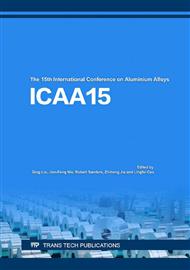[1]
J.S. Robinson, R.L. Cudd , D. A Tanner, G. P Dolan. Quench sensitivity and tensile property inhomogeneity in 7010 forgings, Journal of Materials Processing Technology. 119 (2001) 261-267.
DOI: 10.1016/s0924-0136(01)00927-x
Google Scholar
[2]
V. C Prantil, M. L Callabresi, J. F Lathrop, G. S Ramaswamy, M. T Lusk, Simulating distortion and residual stresses in carburized thin strips. Journal of Engineering Materials and Technology. 125 (2003) 116-124.
DOI: 10.1115/1.1543973
Google Scholar
[3]
D Godard, P Archambault, E Aeby-gautier, G Lapasset, Precipitation sequences during quenching of the AA 7010 alloy, Acta Materialia. 50 (2002) 2319-2329.
DOI: 10.1016/s1359-6454(02)00063-0
Google Scholar
[4]
J. S Robinson, D. A Tanner, C. E Truman, A. M Paradowska, R. C Wimpory, The influence of quench sensitivity on residual stresses in the aluminium alloys 7010 and 7075, Materials Characterization. 65 (2012) 73-85.
DOI: 10.1016/j.matchar.2012.01.005
Google Scholar
[5]
H Gong, Y. X Wu, K Liao, Influence of different quenching techniques on residual stress of 7075 aluminum alloy thick-plate, Journal of Central South University. 41 (2010) 1354-1359.
Google Scholar
[6]
J. S Robinson, D. A Tanner, C. E Truman, 50th Anniversary Article: The origin and management of residual stress in heat-treatable aluminium alloys, Strain. 50 (2014) 185-207.
DOI: 10.1111/str.12091
Google Scholar
[7]
M. J Wang, G Yang, C. Q Huang, B Chen, Simulation of temperature and stress in 6061 aluminum alloy during online quenching process, Transactions of Nonferrous Metals Society of China. 24 (2014) 2168-2173.
DOI: 10.1016/s1003-6326(14)63328-8
Google Scholar
[8]
Z. H Zhang, W. P Wang, H. D Fu, J. X Xie, Effect of quench cooling rate on residual stress, microstructure and mechanical property of a Fe–6. 5 Si alloy, Materials Science and Engineering: A. 530 (2011) 519-524.
DOI: 10.1016/j.msea.2011.10.013
Google Scholar
[9]
X. W Yang, J. C Zhu, Z. H Lai, Y Liu, D He, Z. S Nong, Finite element analysis of quenching temperature field, residual stress and distortion in A357 aluminum alloy large complicated thin-wall workpieces, Transactions of Nonferrous Metals Society of China. 23 (2013).
DOI: 10.1016/s1003-6326(13)62657-6
Google Scholar
[10]
S Masoudi, G Amirian, E Saeedi, M Ahmadi, The effect of quench-induced residual stresses on the distortion of machined thin-walled parts, Journal of Materials Engineering and Performance. 24 (2015) 3933-3941.
DOI: 10.1007/s11665-015-1695-7
Google Scholar
[11]
A Cho, K. P Smith, V Dangerfield, A high strength, heat treatable aluminium alloy: CA, CA 2657331 A1. (2008).
Google Scholar
[12]
Y. B Dong, W. Z Shao, L. X Lu, J. T Jiang, L Zhen. Numerical simulation of residual stress in an Al-Cu Alloy block during quenching and aging, Journal of Materials Engineering and Performance. 24 (2015) 4928-4940.
DOI: 10.1007/s11665-015-1758-9
Google Scholar
[13]
Y. B DONG, W. Z Shao, J. T Jiang, B. Y Zhang, L Zhen, Minimization of residual stress in an Al-Cu Alloy forged plate by different heat treatments, Journal of Materials Engineering and Performance. 24 (2015) 1-10.
DOI: 10.1007/s11665-015-1505-2
Google Scholar
[14]
P Ulysse, Thermo-mechanical characterization of forged coated products during water quench, Journal of Materials Processing Technology. 209 (2009) 5584-5592.
DOI: 10.1016/j.jmatprotec.2009.05.015
Google Scholar
[15]
P Ulysse, R. W Schultz, The effect of coatings on the thermo-mechanical response of cylindrical specimens during quenching, Journal of Materials Processing Technology. 204 (2008) 39-47.
DOI: 10.1016/j.jmatprotec.2007.10.072
Google Scholar
[16]
B. W Xiao, Q. G Wang, P Jadhav, K. Y Li, An experimental study of heat transfer in aluminum castings during water quenching, Journal of Materials Processing Technology. 210 (2010) 2023-(2028).
DOI: 10.1016/j.jmatprotec.2010.07.026
Google Scholar
[17]
G. P Dolan, J. S Robinson, Residual stress reduction in 7175-T73, 6061-T6 and 2017A-T4 aluminum alloys using quench factor analysis, Journal of Materials Processing Technology. 153 (2004) 346-351.
DOI: 10.1016/j.jmatprotec.2004.04.065
Google Scholar
[18]
J. S Robinson, R. L Cudd, D. A Tanner, Thermal stress relief in AA2014 and AA7050 forgings / Proceedings of 15th International Conference on Production Research. Ireland: University of Limerick. (1999) 535-538.
Google Scholar


